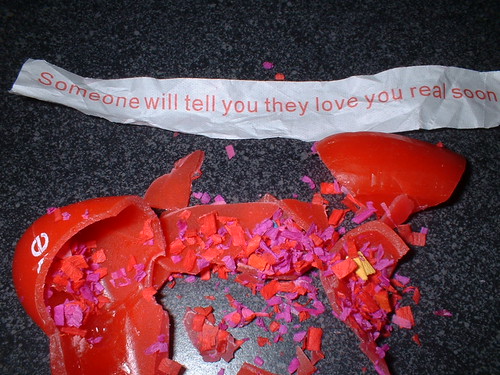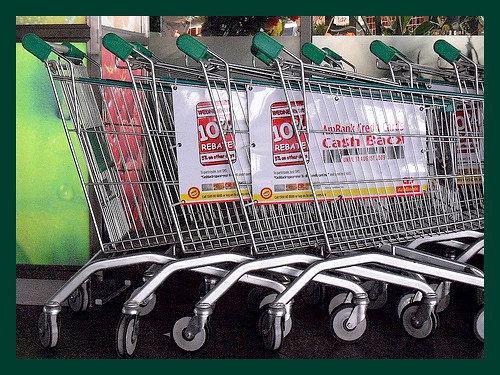
photo credit: kirstyhall
With so many ways to integrate email and social media we have almost unlimited options for leveraging connection between these two powerful conversation marketing channels. Still, for those at the beginning of the process it pays to know where to start.
I’m often asked what
the number one way to connect email and social media marketing is, so whether your presence on social media is brand new or you’re an experienced marketer wanting to make sure you don’t overlook the obvious, here’s my answer:
Use email marketing to invite connections on social media
See more

photo credit: Berto Garcia
. Perhaps stemming from our pioneering roots we equate bigger with better, have a preference for more vs. less (even if it’s far more than we need), and value limitless expanse. Whether it is due to this mentality or other reasons, a similarly pervasive way of thinking has been the mindset in direct marketing for decades.
Yet in an age of awareness about how unfettered human expansion has negatively impacted the environment, times are changing. Sustainability and austerity are in, conspicuous consumption is out. There’s a clear quality over quantity movement underfoot and already visible in social media. I for one say it’s high time this shift made its way fully into email marketing.
See more

photo credit: mscaprikell
: just send them the same type of message repeatedly and you’ll succeed. We're often guilty of this when we send our e-newsletter and little (or nothing) else. And while a newsletter
absolutely has a place as a staple in your email marketing program, it should be far from the only type of message you send your customers on a regular basis.
See more
The U.S. Census Bureau releases the results of its 2010 census this summer and marketers are advised to prepare for some major demographic shifts. In a recent interview I read of Peter Francese, consultant to advertising megalith Ogilvy & Mather and author of the research report 2010 America, I was surprised to learn:
See more

photo credit: mmatins
, at some point you've learned it is polite to say "Thank You". Not only is it proper etiquette, it's just downright considerate and gracious. Yet for marketers, saying thank you is about much more than just being polite. If you're in the business of building lasting, loyal customer relationships (and if you're not, please question why you're bothering to be in business at all) it's an essential practice that pays both monetary and good will dividends. Without it, you're both at greater risk of customer flight and a sitting duck for the competition.
See more

photo credit: D.H. Parks
A little over a year ago, I theorized that 2010 would be the
Year of Conscious Marketing. And while I do think it has taken us more than a year to become conscious of how to use the increasingly fragmented and multiplying online marketing avenues available to us, 2010 certainly was a year in which the “what-how-which” and “why” finally began to gel for many business owners and marketing professionals.
If 2009 was a watershed year – a year in which a lot of activity and change moved through at once – 2010 was what I called a
waterfall year – all that change and activity began to come together in a cohesive flow. Now, in 2011, it’s time to intentionally direct that flow to achieve our goals and desires.
See more

photo credit: doug_wertman
If yours is a services business, B-to-B firm or solo-entrepreneurship, this time of year it can certainly seem like all the marketing focus is on retailers. Yet just because retail eclipses other industries during the holidays doesn’t mean non-retailers can’t take a few lessons from retail marketers and employ similar strategies in their own communications, especially email.
In the spirit of the season, here are three email marketing lessons non-retail businesses can swipe and deploy from holiday retail marketers. Here’s hoping they enlighten your email for 2011!
Vary frequency and cadence seasonally
Retailers live and die by the holiday gift giving season (hence the term “black Friday” for the day after Thanksgiving, traditionally the biggest shopping day of the year on which many retail businesses that haven’t yet made an annual profit will go from “being in the red” to “being in the black”). Even before the days of e-commerce, holiday messaging was much more frequent than advertising done at other times of the year. This increase is easy to see in the email marketing frequency of retailers, which goes from monthly or weekly to as often as weekly or daily during November and December.
It may not be at holiday time, but chances are there is a period or there are seasons when it makes sense to increase
your See more

Creative Commons License photo credit: FindYourSearch
If you’re just tuning into this series,
Part 1 explored the difference between broadcast and triggered-email, explained the role of trigger-based email, and defined the fundamental characteristics that make it so powerful.
Part 2 took a deep dive into the first two of four must-have triggered-email campaigns no email marketing program should be without:
welcome and
re-marketing campaigns. Here in Part 3, we’ll wrap things up with a look at the last two of four essential triggered-email campaigns:
up-sell/cross-sell and
reactivation campaigns.
The Up-Sell/Cross-Sell: Are You Leaving Money on the Table?
Too many marketers think about email campaigns as singular blasts rather than as a
progression of offers and information interwoven into a conversation – a conversation designed to maximize customer lifetime value. There are plenty of
great tips for building ongoing engagement and loyalty with your list members here. Still, if you’re thinking in terms of “one and done” campaigns, it’s time to develop an up-sell/cross-sell trigger program.
Here are three types of up-sell/cross-sell triggered email campaigns to implement during or after the conversion process.
See more

photo credit: fiercehugs
If you’re not using your blog sidebar to request email addresses and other communication touch points from your readers you’re missing out on one of the best and most trustworthy avenues for building your list - essential to increasing engagement, loyalty and sales.
Here are the three top blog sidebar elements every marketer using email should never be without:
Get New Blog Posts by Email
Assuming you have interesting - if not remarkable! - content on your blog, your readers will be interested in coming back to read more so make it easy for them. A common method that alerts subscribers when you have new posts is RSS (it stands for Really Simple Syndication). Readers can subscribe to your RSS feed and see in their RSS reader when you have a new post. However, many people still don’t use RSS, so give your readers an option to receive new blog posts via email.
See more










